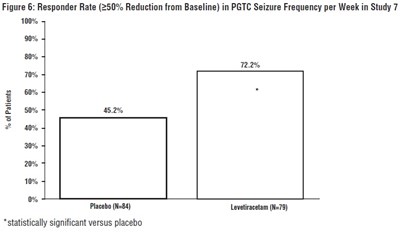Product Images Levetiracetam
View Photos of Packaging, Labels & Appearance
- Figure 1: Responder Rate (≥50% Reduction from Baseline) in Study 1 - levetiracetam fig1
- Figure 2: Responder Rate (≥50% Reduction from Baseline) in Study 2: Period A - levetiracetam fig2
- Figure 3: Responder Rate (≥50% Reduction from Baseline) in Study 3 - levetiracetam fig3
- Figure 4: Responder Rate (≥ 50% Reduction from Baseline) in Study 4 - levetiracetam fig4
- Figure 5: Responder Rate for All Patients Ages 1 Month to < 4 Years (≥ 50% Reduction from Baseline) in Study 5 - levetiracetam fig5
- Figure 6: Responder Rate (≥50% Reduction from Baseline) in PGTC Seizure Frequency per Week in Study 7 - levetiracetam fig6
- Levetiracetam Tablet USP 500mg - levetiracetam fig7
- Chemical Structure - levetiracetam str
Product Label Images
The following 8 images provide visual information about the product associated with Levetiracetam NDC 68788-7592 by Preferred Pharmaceuticals, Inc., such as packaging, labeling, and the appearance of the drug itself. This resource could be helpful for medical professionals, pharmacists, and patients seeking to verify medication information and ensure they have the correct product.
Figure 1: Responder Rate (≥50% Reduction from Baseline) in Study 1 - levetiracetam fig1

The figure shows the Responder Rate in Study 1 with a 250% reduction from baseline. The percentages range from 0% to 39.6%, with a statistically significant difference from the placebo. The text also mentions the names Leviaseam and Levieacl with corresponding quantities in ooy.*
Figure 2: Responder Rate (≥50% Reduction from Baseline) in Study 2: Period A - levetiracetam fig2

The text describes Figure 2 showing the Responder Rate (250% Reduction from Baseline) in Study 2, Period A. It presents a graph with the percentages of patients who responded to the treatment with Levetiracetam 1000 mg/day and Levetiracetam 2000 mg/day, as well as the placebo, indicating that the differences in response rates between Levetiracetam and placebo were statistically significant.*
Figure 3: Responder Rate (≥50% Reduction from Baseline) in Study 3 - levetiracetam fig3

This is a chart displaying the responder rate, which indicates a reduction of over 50% from baseline, in Study 3. The chart compares the responder rates for the group that received a placebo (N=104) and the group that received Levetiracetam 3000 mg/day (N=180). The responder rate for the Levetiracetam group was 45%, which was statistically significant compared to the placebo group's responder rate of 14.4%. However, there was no responder rate indicated for the group who received the placebo or Levetiracetam.*
Figure 4: Responder Rate (≥ 50% Reduction from Baseline) in Study 4 - levetiracetam fig4

This is a graph showing the Responder Rate in Study 4 for a Placebo group and a group taking Levetiracetam. The Responder Rate is defined as a 50% reduction from the baseline. The percentages are shown on the y-axis and range from 0% to 50%. The Placebo group had a Responder Rate of 19.6%, while the Levetiracetam group had a Responder Rate of 44.6%. The Levetiracetam group had statistically significant results compared to the placebo group.*
Figure 5: Responder Rate for All Patients Ages 1 Month to < 4 Years (≥ 50% Reduction from Baseline) in Study 5 - levetiracetam fig5

This figure shows the responder rate for patients aged 1 month to less than 4 years in Study 5, with a reduction of over 50% from baseline. The percentages are obscured by illegible characters. The study compared Lovetracatam to placebo, and Lovetracatam was found to be statistically significant.*
Figure 6: Responder Rate (≥50% Reduction from Baseline) in PGTC Seizure Frequency per Week in Study 7 - levetiracetam fig6

The text describes a figure labeled as "Figure 6" which shows the responder rate of patients with PGTC seizure frequency per week in Study 7. The figure displays a graph with a range of percentages from 0% to 100%. Two bars are compared, one labeled "Placebo" with 84 patients and the other labeled "Levetiracetam" with 79 patients. The graph shows that the Levetiracetam group had a 72.2% reduction from baseline in PGTC seizure frequency per week, which is statistically significant compared to the placebo. The percentage of patients who responded to Levetiracetam treatment is 45.2%. Approximately 9% of patients did not respond to either treatment.*
* The product label images have been analyzed using a combination of traditional computing and machine learning techniques. It should be noted that the descriptions provided may not be entirely accurate as they are experimental in nature. Use the information in this page at your own discretion and risk.

